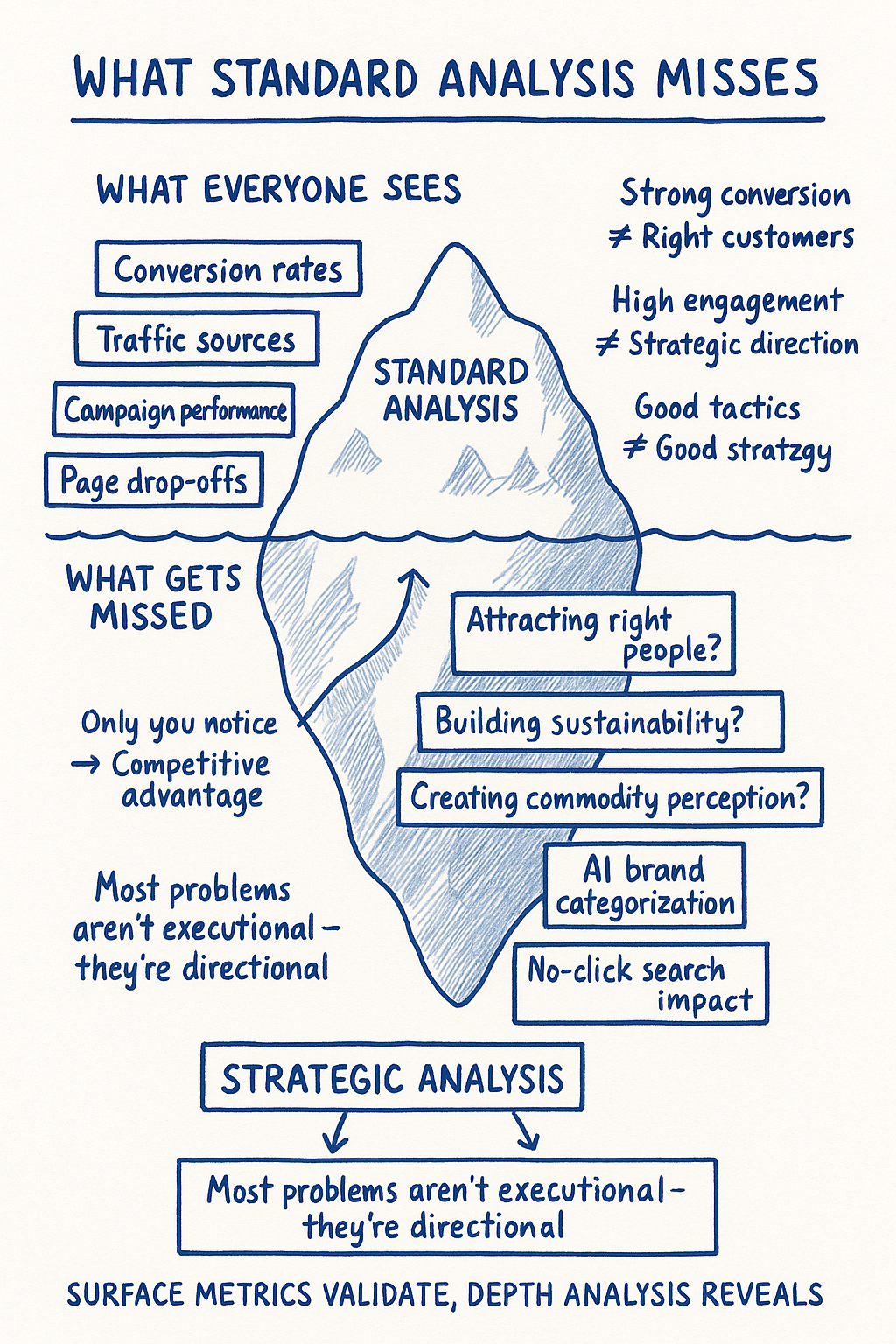Marketing Performance Audits & Diagnostics

Performance Audits & Diagnostics show exactly what's working and what's wasting time. Not just metrics. We uncover where your strategy stalls. Where your technology underperforms. And where you lose conversion, everywhere they matter. This analysis connects to comprehensive content strategy that ensures your messaging and positioning align with what the data reveals about your market position.
Problems aren't mystery puzzles. They're patterns with a point to make.
You've got data. Dashboards. Attribution. A full stack of tools. But something still feels off.
Numbers can lie by telling incomplete truths. Your data might show growth while your competitive position weakens. Traffic might increase while qualified leads decrease. Engagement might spike while revenue stagnates.
The issue isn't your data. It's that everyone's reading the same surface-level signals while the real story sits buried in patterns no one's connecting. And now, with AI systems increasingly determining who gets found, the patterns that matter are changing faster than most measurement systems can track.
The Cost of Looking at Numbers Instead of Reality
Surface-level reporting creates dangerous blind spots. Teams optimize for what's easy to measure rather than what actually drives results, slowly drifting away from what made them successful in the first place.
An LA fitness company came to us celebrating their "best year ever" based on social media buzz and celebrity endorsements. The dashboard looked fantastic: viral posts, strong conversion rates, solid membership growth.
But their retention rates had dropped 35% over two years. Class utilization was declining. While competitors were seeing 20% annual growth in member spend, theirs stayed flat. They were attracting fitness enthusiasts who wanted to train like stars, but couldn't sustain the intensity or expense long-term.
The surface numbers hid a fundamental positioning problem. Their celebrity trainer focus was attracting the wrong customers while completely missing the larger, more profitable market of busy professionals who needed their expertise but required flexibility around chaotic schedules. Success in buzz was masking failure in direction.
What they didn't realize: their messaging was also training AI systems to categorize them as 'celebrity fitness' rather than 'professional fitness solutions.' When busy executives searched for sustainable fitness options, answer engines weren't surfacing them at all. Fixing this requires answer engine optimization that aligns content structure with how AI systems categorize and surface expertise.
What Standard Analysis Misses

Traditional audits focus on channel optimization and conversion rates. They'll tell you which campaigns drove traffic, which pages convert best, and where visitors drop off.
But they won't tell you whether you're attracting the right people, building toward something sustainable, or inadvertently training your market to see you as a commodity. They also won't reveal how AI systems are interpreting and categorizing your brand, or whether the traffic you're losing to no-click searches is actually helping or hurting your business.
Here's what gets missed: teams assume that good tactical performance equals good strategic direction. Strong conversion rates feel like validation, but they might just mean you're really good at attracting the wrong customers. High engagement might signal audience interest, or it might mean you're teaching prospects to evaluate you exactly like everyone else.
The metrics everyone tracks become table stakes. The patterns only you notice become competitive advantages. But most analysis stops at the surface level where everyone's looking at the same signals and reaching the same conclusions.
Most problems aren't executional. They're directional. Your tactics might be working perfectly while your strategy slowly limits your business.
The New Layer of Performance Complexity
The shift toward AI-mediated discovery is creating a completely different performance landscape. Traffic patterns that looked problematic six months ago might actually indicate higher-quality engagement. Shorter sessions might mean more focused visitors. Lower click-through rates from search might correlate with higher revenue per visitor.
Traditional performance frameworks weren't built for this complexity. They measure the old game while a new one emerges alongside it. Teams need diagnostic approaches that account for both the direct relationship between marketing and conversion, and the indirect influence of AI systems on who finds you and how they arrive.
What Honest Assessment Reveals
Teams often avoid deep diagnosis because it reveals uncomfortable truths. Maybe your fastest-growing channel attracts your least profitable customers. Maybe your most successful campaigns are slowly commoditizing your positioning. Maybe your best-converting content is teaching prospects to evaluate you like everyone else.
These insights require real changes, not tactical tweaks. Most teams prefer fixing what's easy to fix rather than addressing what actually needs fixing.
What We Actually Look For
We examine the whole system: how your positioning affects your targeting, how your messaging shapes prospect expectations, how your channels reinforce or contradict your brand promise. And increasingly, how AI systems interpret and surface your brand across the discovery journey. Understanding these positioning patterns requires brand narrative analysis that reveals how your story translates across different contexts and audiences.
Where does energy build versus where does it leak? Which marketing efforts create momentum that sales teams can build on? Which campaigns attract prospects who become long-term customers versus one-time buyers? How are changing search behaviors affecting the quality and intent of your traffic?
Your numbers exist within a competitive landscape that's shifting rapidly. Strong results in isolation might be weak relative to market opportunity or competitive threats. Growth that doesn't build lasting advantage isn't growth. It's expensive customer acquisition.
We look for the patterns that reveal whether you're building toward something sustainable or optimizing toward a cliff edge.
The Reality
This isn't a teardown. It's a pressure check. Not to burn it all down, but to find what's quietly undermining your competitive position before it becomes obvious to everyone else.
Companies that regularly examine their direction alongside their tactics stay ahead of problems rather than reacting to them. They catch positioning drift before it becomes positioning crisis. And they adapt to changing discovery patterns before competitors figure out what's happening.
The goal isn't perfect measurement. It's useful insight that helps you make better decisions about where to focus next.
Frequently Asked Questions
What is a performance audit?
It's a comprehensive look at how your marketing system actually performs. We map where strategy disconnects from execution, why strong tactics aren't building competitive advantage, and what patterns your current analytics miss completely.
How is a diagnostic different from an audit?
An audit spots issues. A diagnostic explains them. Performance diagnostics uncover root causes—whether it's positioning drift, audience mismatch, or changing discovery patterns—so fixes address what's actually broken.
Who should invest in performance audits?
Anyone who's watched metrics improve while business results stagnate. If your campaigns are working but your competitive position is weakening—or if strong performance feels disconnected from sustainable growth—it's time for deeper diagnosis.
The strategist behind the services.
All our offerings are stronger under unified leadership. That's what the Fractional CMO role provides.
Unite Your Strategy